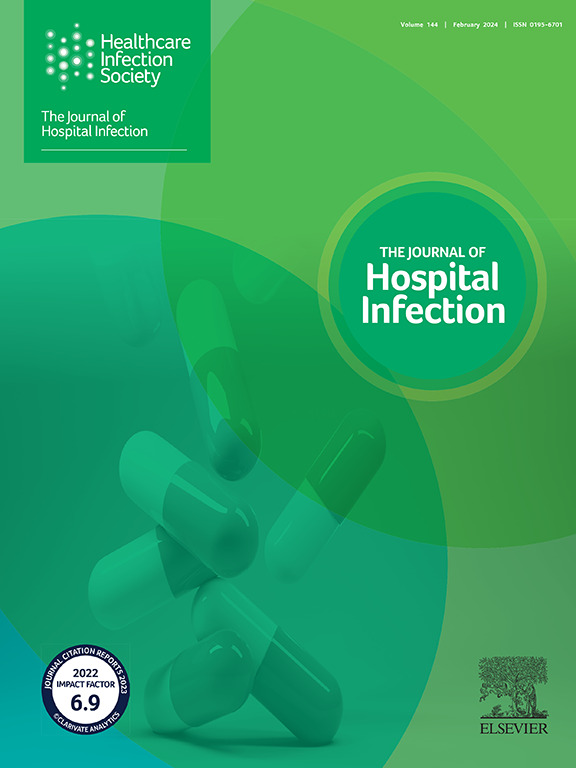急性呼吸道病毒感染的参与者在咳嗽时检测到空气中颗粒中的活病毒。
IF 3.1
3区 医学
Q1 INFECTIOUS DISEASES
引用次数: 0
摘要
目的:本研究旨在评估感染呼吸道病毒的参与者在自愿咳嗽时产生的呼出颗粒中空气传播病毒的存活情况。方法:我们采用一种新技术,招募各种呼吸道感染的患者,进行实时聚合酶链反应(rt-PCR)和培养分析。在13名因pcr阳性呼吸道病毒感染而就诊的参与者咳嗽后,呼吸道颗粒在空气中老化,以达到与环境相对湿度的平衡。结果:鼻咽拭子rt-PCR鉴定出以下单例感染;5种甲型流感病毒(IAV)、3种呼吸道合胞病毒(RSV)、1种鼻病毒、1种副流感病毒(PIV)-3和1种PIV-4。发现2例合并感染:1例RSV/IAV和1例RSV/人冠状病毒HCoV-HKU1。通过rt-PCR从13名参与者中的9名(69%)收集的咳嗽颗粒中鉴定出病毒,从13名参与者中的7名(54%)中检出活病毒(IAV (1), RSV (4), PIV-3 (1), HCoV-HKU1(1))。rsv感染的参与者比流感参与者释放更多的呼吸道颗粒,中位数为1.07 × 104±19.9 × 103颗粒/L (P=0.044)。结论:我们的研究证明了在老年人咳嗽颗粒中检测到多种可存活的呼吸道病毒,包括对PIV和RSV感染的新见解,并强调了通过空气传播的风险。本文章由计算机程序翻译,如有差异,请以英文原文为准。
Viable viruses in airborne particles detected during cough by participants with acute respiratory viral infections
Aim
This study aimed to evaluate the survival of airborne viruses in exhaled particles produced during voluntary coughing by participants infected with respiratory viruses.
Methods
We utilized a novel technique, recruiting patients with diverse respiratory infections and performing real-time polymerase chain reaction (rt-PCR) and culture analyses. Respiratory particles were aged in an airborne state to reach equilibrium with ambient relative humidity following cough in 13 participants who presented to hospital with PCR-positive respiratory viral infections.
Findings
Nasopharyngeal swab rt-PCR identified the following single infections; five influenza A virus (IAV), three respiratory syncytial virus (RSV), one rhinovirus, one parainfluenza virus (PIV)-3, and one PIV-4. Two co-infections were identified: one RSV/IAV and one RSV/human coronavirus HCoV-HKU1. Virus was identified by rt-PCR in cough particles collected from nine of 13 (69%) participants, with viable virus recovered from seven of 13 (54%) participants (IAV (one), RSV (four), PIV-3 (one), HCoV-HKU1 (one)). RSV-infected participants shed more respiratory particles than influenza participants, with a median of 1.07 × 104 ± 19.9 × 103 particles/L (P=0.044).
Conclusion
Our study demonstrates the detection of diverse and viable respiratory viruses, including new insights of PIV and RSV infection in aged cough particles, and highlights the risk of transmission through the air.
求助全文
通过发布文献求助,成功后即可免费获取论文全文。
去求助
来源期刊

Journal of Hospital Infection
医学-传染病学
CiteScore
12.70
自引率
5.80%
发文量
271
审稿时长
19 days
期刊介绍:
The Journal of Hospital Infection is the editorially independent scientific publication of the Healthcare Infection Society. The aim of the Journal is to publish high quality research and information relating to infection prevention and control that is relevant to an international audience.
The Journal welcomes submissions that relate to all aspects of infection prevention and control in healthcare settings. This includes submissions that:
provide new insight into the epidemiology, surveillance, or prevention and control of healthcare-associated infections and antimicrobial resistance in healthcare settings;
provide new insight into cleaning, disinfection and decontamination;
provide new insight into the design of healthcare premises;
describe novel aspects of outbreaks of infection;
throw light on techniques for effective antimicrobial stewardship;
describe novel techniques (laboratory-based or point of care) for the detection of infection or antimicrobial resistance in the healthcare setting, particularly if these can be used to facilitate infection prevention and control;
improve understanding of the motivations of safe healthcare behaviour, or describe techniques for achieving behavioural and cultural change;
improve understanding of the use of IT systems in infection surveillance and prevention and control.
 求助内容:
求助内容: 应助结果提醒方式:
应助结果提醒方式:


